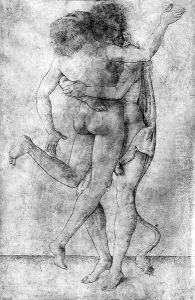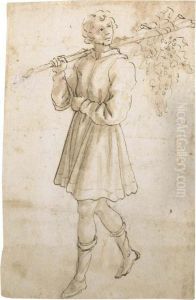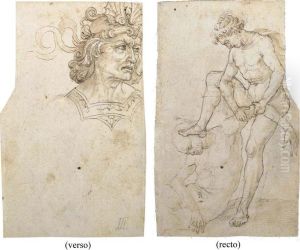Maso Finiguerra Paintings
Maso Finiguerra was an Italian goldsmith, engraver, and draftsman, born in 1426 in Florence, Italy. He is often credited with the invention or at least the early development of the printmaking technique of engraving, specifically the process known as niello, although this claim has been debated among art historians. Finiguerra's work bridged the gap between the craftsmanship of goldsmithing and the emerging art of printmaking during the Renaissance.
Finiguerra began his career as an apprentice in the workshop of the renowned goldsmith Lorenzo Ghiberti, who created the famous bronze doors of the Florence Baptistery. Here, he learned the art of metalworking and engraving, which he later refined in his own workshop. His skill in engraving was such that he created designs for niello, a black mixture used to fill in engraved designs on silver or gold objects, which imparted a dramatic contrast and intricate detail to the works.
Although he was a master goldsmith, Finiguerra is best known for his contribution to printmaking. The technique associated with him, the 'Finiguerra method,' involved taking an impression of the niello design on a piece of paper before it was inlaid into the metal object. This was achieved by filling the engraved lines with niello and then firmly pressing dampened paper onto the surface, transferring the design. This process is considered an early form of printmaking, predating the wide use of engraving on copper plates for creating prints.
Finiguerra's prints are rare, and few have survived to the present day. However, his impact on the art world was significant, particularly in the dissemination of the niello technique, which contributed to the broader development of printmaking as a form of art. His work is known for its fine detail and the elegance of its line, reflecting the aesthetic values of the early Renaissance in Florence.
Although he did not achieve widespread fame during his lifetime, Finiguerra's legacy lived on through the artists he influenced. His work was recognized for its quality and intricacy, and he was mentioned by Giorgio Vasari in his seminal work 'Lives of the Most Excellent Painters, Sculptors, and Architects.' Finiguerra died in 1464 in Florence, where he had spent the majority of his life and career. His contributions remain a significant footnote in the history of early printmaking and the art of the Italian Renaissance.


